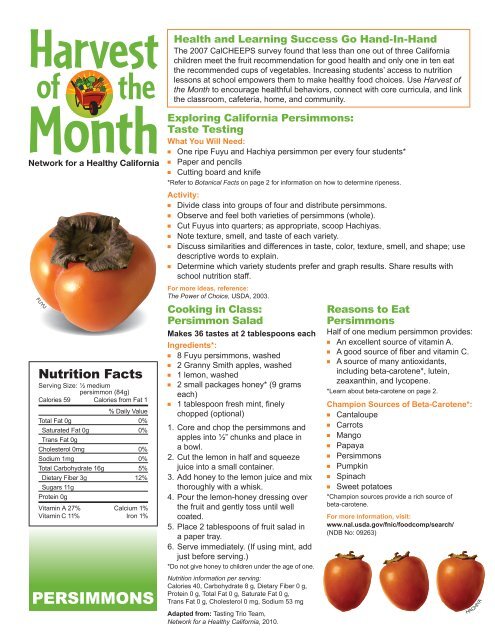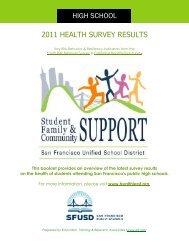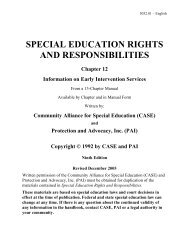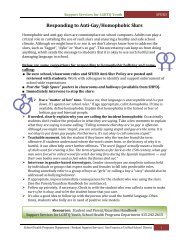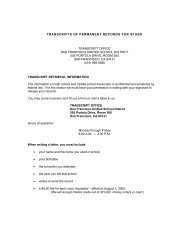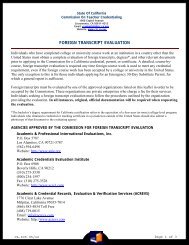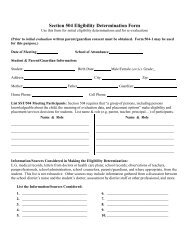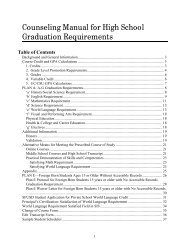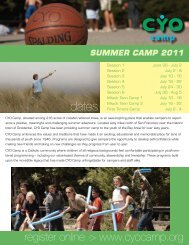Exploring California Persimmons - Harvest of the Month
Exploring California Persimmons - Harvest of the Month
Exploring California Persimmons - Harvest of the Month
You also want an ePaper? Increase the reach of your titles
YUMPU automatically turns print PDFs into web optimized ePapers that Google loves.
Health and Learning Success Go Hand-In-HandThe 2007 CalCHEEPS survey found that less than one out <strong>of</strong> three <strong>California</strong>children meet <strong>the</strong> fruit recommendation for good health and only one in ten eat<strong>the</strong> recommended cups <strong>of</strong> vegetables. Increasing students’ access to nutritionlessons at school empowers <strong>the</strong>m to make healthy food choices. Use <strong>Harvest</strong> <strong>of</strong><strong>the</strong> <strong>Month</strong> to encourage healthful behaviors, connect with core curricula, and link<strong>the</strong> classroom, cafeteria, home, and community.Network for a Healthy <strong>California</strong>FUYUNutrition FactsServing Size: ½ mediumpersimmon (84g)Calories 59 Calories from Fat 1% Daily ValueTotal Fat 0g 0%Saturated Fat 0g 0%Trans Fat 0gCholesterol 0mg 0%Sodium 1mg 0%Total Carbohydrate 16g 5%Dietary Fiber 3g 12%Sugars 11gProtein 0gVitamin A 27% Calcium 1%Vitamin C 11% Iron 1%PERSIMMONS<strong>Exploring</strong> <strong>California</strong> <strong>Persimmons</strong>:Taste TestingWhat You Will Need:n One ripe Fuyu and Hachiya persimmon per every four students*n Paper and pencilsn Cutting board and knife*Refer to Botanical Facts on page 2 for information on how to determine ripeness.Activity:n Divide class into groups <strong>of</strong> four and distribute persimmons.n Observe and feel both varieties <strong>of</strong> persimmons (whole).n Cut Fuyus into quarters; as appropriate, scoop Hachiyas.n Note texture, smell, and taste <strong>of</strong> each variety.n Discuss similarities and differences in taste, color, texture, smell, and shape; usedescriptive words to explain.n Determine which variety students prefer and graph results. Share results withschool nutrition staff.For more ideas, reference:The Power <strong>of</strong> Choice, USDA, 2003.Cooking in Class:Persimmon SaladMakes 36 tastes at 2 tablespoons eachIngredients*:n 8 Fuyu persimmons, washedn 2 Granny Smith apples, washedn 1 lemon, washedn 2 small packages honey* (9 gramseach)n 1 tablespoon fresh mint, finelychopped (optional)1. Core and chop <strong>the</strong> persimmons andapples into ½” chunks and place ina bowl.2. Cut <strong>the</strong> lemon in half and squeezejuice into a small container.3. Add honey to <strong>the</strong> lemon juice and mixthoroughly with a whisk.4. Pour <strong>the</strong> lemon-honey dressing over<strong>the</strong> fruit and gently toss until wellcoated.5. Place 2 tablespoons <strong>of</strong> fruit salad ina paper tray.6. Serve immediately. (If using mint, addjust before serving.)*Do not give honey to children under <strong>the</strong> age <strong>of</strong> one.Nutrition information per serving:Calories 40, Carbohydrate 8 g, Dietary Fiber 0 g,Protein 0 g, Total Fat 0 g, Saturate Fat 0 g,Trans Fat 0 g, Cholesterol 0 mg, Sodium 53 mgAdapted from: Tasting Trio Team,Network for a Healthy <strong>California</strong>, 2010.Reasons to Eat<strong>Persimmons</strong>Half <strong>of</strong> one medium persimmon provides:n An excellent source <strong>of</strong> vitamin A.n A good source <strong>of</strong> fiber and vitamin C.n A source <strong>of</strong> many antioxidants,including beta-carotene*, lutein,zeaxanthin, and lycopene.*Learn about beta-carotene on page 2.Champion Sources <strong>of</strong> Beta-Carotene*:n Cantaloupen Carrotsn Mangon Papayan <strong>Persimmons</strong>n Pumpkinn Spinachn Sweet potatoes*Champion sources provide a rich source <strong>of</strong>beta-carotene.For more information, visit:www.nal.usda.gov/fnic/foodcomp/search/(NDB No: 09263)HACHIYA
What is Beta-Carotene?n Beta-carotene is a member <strong>of</strong> <strong>the</strong> carotenoids,which are a class <strong>of</strong> more than 600 naturallyoccurring pigments syn<strong>the</strong>sized by plants, algae, andphotosyn<strong>the</strong>tic bacteria.n Caroteroids are highly colored (red, orange, yellow),fat-soluble compounds naturally occurring in manyfruits and vegetables (leafy greens, carrots, sweetpotatoes, squash, spinach, apricots, and greenpeppers).n The carotene family possesses antioxidant properties.Alpha-, beta-, and gamma-carotene are considered“provitamins” because <strong>the</strong>y can be converted to activevitamin A.n Vitamin A serves several functions in <strong>the</strong> body. I<strong>the</strong>lps maintain good vision, fight infection, support cellgrowth, and keep skin healthy.For more information, visit:http://lpi.oregonstate.edu/infocenter/phytochemicals/carotenoids/#biological_activityhttp://www.mayoclinic.com/health/beta-carotene/NS_patientbetacaroteneHow Do <strong>Persimmons</strong> Grow?The persimmon is a deciduous tree, adaptable to awide range <strong>of</strong> soils and climates and immune from mostdiseases and insects. Although <strong>the</strong> trees can withstandtemperatures as low as zero degrees when fully dormant,<strong>the</strong>y do not produce well in high summer heat or desertregions. Trees are ei<strong>the</strong>r male or female, but some haveboth male and female flowers; sexual expression can alsovary from year to year. Reaching heights <strong>of</strong> up to 25 feet,trees bear fruit about two to three years after grafting andhave a life span <strong>of</strong> about 10 years.For more information, visit:www.crfg.org/pubs/ff/persimmon.htmlwww.nal.usda.govsepalovaryovulesterile stamenspetalnectarystigmasepalImage adapted from:www284.pair.com/florists/all-about-flowers/Persimmon.htmFloral terminology provided by E. Sandoval, Curator, College <strong>of</strong> BiologicalSciences Greenhouses, University <strong>of</strong> <strong>California</strong>, Davis.To download reproducible botanical images and for more growinginformation, visit www.harvest<strong>of</strong><strong>the</strong>month.com.Botanical FactsPronunciation: pər-sĭm’ənSpanish name: persimoFamily: EbenaceaeGenus: DiospyrosSpecies: D. kakiAncient references to <strong>the</strong>persimmon as “food for <strong>the</strong> gods” have led to itsclassification in <strong>the</strong> genus Diospyros <strong>of</strong> <strong>the</strong> Ebony family.(“Dios” means God; “pyros” means grain or food.) TheEnglish word “persimmon” is derived from <strong>the</strong> Algonquianlanguage <strong>of</strong> <strong>the</strong> eastern United States meaning “dry fruit.”Today, all persimmons cultivated in <strong>California</strong> (andmost in <strong>the</strong> United States) are <strong>of</strong> <strong>the</strong> D. kaki species.Although native to China, this species is <strong>of</strong>ten referred toas Japanese or Oriental persimmons.* These fruits aregenerally divided into two categories: astringent andnon-astringent.AstringentVarieties Hachiya FuyuColorBright, deeporange-redNon-astringentLight orangeShape Acorn-shaped Spherical,pumpkin-shapedUse**Must be jelly s<strong>of</strong>tbefore it is edible;used mostly forbakingMay be eaten rawwhen firm or s<strong>of</strong>t*See A Slice <strong>of</strong> Persimmon History on page 3 for origin.**To ripen firm astringent varieties, store at room temperature. To expediteprocess, place in paper bag with apple or banana.For more information, visit:www.sdfarmbureau.org/fuyuHow Much Do I Need?Half <strong>of</strong> one medium persimmon is about a ½ cup <strong>of</strong>fruit. This is about <strong>the</strong> size <strong>of</strong> one cupped handful. Theamount <strong>of</strong> fruits and vegetables that each person needsdaily depends on age, gender, and physical activity level.Encourage students to find out how many cups <strong>of</strong> fruits andvegetables <strong>the</strong>y need to eat daily and keep a tracking logto monitor if <strong>the</strong>y are meeting <strong>the</strong>ir needs. Remind studentsthat <strong>the</strong>y also need to get at least 60 minutes <strong>of</strong> physicalactivity every day.Recommended Daily Amount <strong>of</strong>Fruits and Vegetables*Kids,Ages 5-12Teens and Adults,Ages 13 and upMales 2½ - 5 cups per day 4½ - 6½ cups per dayFemales 2½ - 5 cups per day 3½ - 5 cups per day*If you are active, eat <strong>the</strong> higher number <strong>of</strong> cups per day.Visit www.choosemyplate.gov to learn more.
S tudent Sleuths1 Some persimmon varietiescontain tannins, whichcause astringency. Whatare tannins? What areo<strong>the</strong>r sources <strong>of</strong> tannins?2 <strong>Persimmons</strong> are high inantioxidants. What areantioxidants and what do<strong>the</strong>y do for <strong>the</strong> body?3 What is beta-carotene? Describe how beta-carotene isconverted to vitamin A in <strong>the</strong> body.4 Create a presentation on several fruits and vegetablesfrom different parts <strong>of</strong> <strong>the</strong> plant we eat (roots, seeds,leaves, fruits, etc.). List <strong>the</strong> key nutrients found in eachitem and <strong>the</strong> health benefits <strong>of</strong> <strong>the</strong>se nutrients.5 What are <strong>the</strong> top three persimmon-producing countiesin <strong>California</strong>? Locate on a map. When do <strong>the</strong>seregions harvest persimmons? What similarities are<strong>the</strong>re between <strong>the</strong>se counties (e.g., climate, location,geography)?For information, visit:www.crfg.org/pubs/ff/persimmon.htmlwww.nal.usda.gov/fnic/foodcomp/search/A Slice <strong>of</strong> Persimmon Historyn The D. kaki species originated in China and made itsway to Japan more than a thousand years ago.*n Commodore Perry brought seeds back to <strong>the</strong> UnitedStates from Japan after his 1852-54 expedition. Theseeds were first planted in <strong>the</strong> area around Washington,D.C., but were killed by an early frost.n In 1870, grafted trees were successfully introduced intoGeorgia and <strong>California</strong> by early USDA plant explorers.n At least 500 different D. kaki varieties were broughtto <strong>California</strong> during a major planting spree from 1870to 1920. In 1877 alone, more than 5,000 plants in 19varieties were imported from Japan.n Today, <strong>the</strong> two major Japanese varieties grown in<strong>California</strong> are <strong>the</strong> Hachiya and <strong>the</strong> Fuyu.*<strong>Persimmons</strong> <strong>of</strong> <strong>the</strong> species D. virginiana (American persimmon) arenative to North America, mostly on <strong>the</strong> East Coast. While it was a foodstaple <strong>of</strong> early Native Americans, <strong>the</strong> species today accounts for less than1 percent <strong>of</strong> <strong>the</strong> country’s total crop production.For more information, reference:Chez Panisse Fruit, Alice Waters, 2002.http://food.oregonstate.edu/faq/uffva/persimmon2.htmlSchool Garden: Cover CropsIf your school has a garden, here is an activity you may want to implement.Look for donations to cover <strong>the</strong> cost <strong>of</strong> seeds, tools, irrigation systems,electric pumps, and any salary incurred by garden educators or o<strong>the</strong>rs.Late fall is an ideal time to clean up <strong>the</strong> garden fromsummer and prepare it for winter using a cover crop.Cover crops provide soil cover and prevent soil erosion.A legume is a great choice for a winter cover crop for <strong>the</strong>added benefit <strong>of</strong> nitrogen. Easy to grow nitrogen rich plantsare: red clover, alfalfa, fava beans, or peas. Humans needprotein to grow properly. Nitrogen is a component <strong>of</strong> <strong>the</strong>protein foods that we eat. Animal and plant foods provideus with protein in our diet.Activity:Have students identify protein foods that come from animaland plant sources. This can be done with pictures <strong>of</strong>different types <strong>of</strong> food. Discuss how we can eat plant foodshigh in protein to replace animal protein in a meal.For more ideas, reference:The Growing Classroom, Roberta Jaffe and Gary Appel, Life Lab ScienceProgram, 1990, pp. 93-95.Home Grown Factsn In 2004, <strong>California</strong> produced 99 percent<strong>of</strong> <strong>the</strong> D. kaki crop in <strong>the</strong> United States.n Tulare and Fresno counties produce53 percent <strong>of</strong> <strong>the</strong> state’s total production.n O<strong>the</strong>r major persimmon-producing regionsinclude Orange, Riverside, and San Diegocounties. A small percentage is grown in Sutter andPlacer counties.n <strong>Persimmons</strong> reached <strong>the</strong>ir peak in popularity during<strong>the</strong> first half <strong>of</strong> <strong>the</strong> 20th century. The Hachiya was <strong>the</strong>preferred variety, but production declined and has sincebeen surpassed by <strong>the</strong> Fuyu.For more information, visit:www.cdfa.ca.govwww.crfg.org/pubs/ff/persimmon.htmlJust <strong>the</strong> Factsn In Asia, persimmons have been cultivated for thousands<strong>of</strong> years and rank next to citrus fruit in importance,culturally and economically.n The persimmon is Japan’s national fruit.n The art <strong>of</strong> hoshigaki — hand-dried persimmons — isan integral part <strong>of</strong> traditional Japanese New Year’scelebrations.n The Fuyu was developed by breeding out <strong>the</strong> tannic acidfrom <strong>the</strong> Hachiya, making it more appealing to taste andeasier to eat whole and raw.n Persimmon trees are also cultivated for timber(used in golf clubs, textile weaving, and furniture),wildlife (flowers produce nectar for honeybees), andbeautification.Source:Chez Panisse Fruit, Alice Waters, 2002.www.mfc.state.ms.us/seedlings/
S tudent ChampionsAfter <strong>the</strong> persimmon was introduced in America in <strong>the</strong> late1800s, it became one <strong>of</strong> <strong>the</strong> country’s most popular fruits,particularly in <strong>California</strong>. Although <strong>California</strong> continues tolead <strong>the</strong> nation in persimmon production, its popularityhas declined considerably. Using what <strong>the</strong>y have learnedin class, students can “re-introduce” <strong>the</strong> persimmon to <strong>the</strong>community.n Write an article that describes <strong>the</strong> two main varieties and<strong>the</strong> nutritional benefits. Include examples <strong>of</strong> how <strong>the</strong>ycan be used in meals and recipes. Submit articles tolocal print outlets.n Design posters or brochures to promote <strong>the</strong> nutritionalbenefits and uses <strong>of</strong> persimmons. Include healthyholiday recipes. Display on campus or at grocery stores,persimmon stands, or farmers’ markets.Physical Activity CornerMovement increases breathing and heart rate so that moreblood flows to <strong>the</strong> brain. Integrating physical activity into<strong>the</strong> classroom can help optimize student performance.Objective:Kines<strong>the</strong>tic movement, nutrition educationActivity:n Students jump up and down (or hop on one leg)*n Call out one <strong>of</strong> <strong>the</strong> fruit/vegetable color groups (red,green, yellow/orange, etc.)n One at a time, each student calls out a fruit or vegetablewithin named color groupn Continue for all color groups*Variations may involve identifying different movements to represent fruitsand vegetables or <strong>the</strong> different color groups. For example, jumping mayrepresent red fruits while running in place may represent blue/purplevegetables.For more ideas, visit:www.take10.netCafeteria ConnectionsThe sweet and spicy Fuyu has apricot and cinnamonflavors that are appealing to children. It is easy to prepareand does not brown quickly. Introduce students to thisunique fruit by incorporating it into <strong>the</strong> school menu. Shareserving ideas with school nutrition staff.n Use firm Fuyus as a “cracker” and pair with o<strong>the</strong>r fruitsor lowfat cheese.n Pair Fuyu with a crisp vegetable and a dip.n Offer sliced or shredded persimmons in <strong>the</strong> salad bar.O<strong>the</strong>r ideas for incorporating persimmons.n Ask students (grades K-5) to develop a snack recipe.n Ask students (grades 6-8) to develop a lunch recipe.n Ga<strong>the</strong>r healthy holiday recipes that contain persimmonsto share with students and families.For more ideas, visit:www.fns.usda.gov/tn/Literature LinksAsk librarian to help students with a research project.Divide students into groups to research <strong>the</strong> ancientJapanese art <strong>of</strong> hoshigaki. Have students select a topic <strong>of</strong>interest and present findings to class in <strong>the</strong> library. Topicsmay include:n Demonstration <strong>of</strong> method used to hand-dry <strong>the</strong> fruitn How <strong>the</strong> practice/art evolved and how it is different todayn Historical significance in Asian culturen Global locations <strong>of</strong> where it is practiced todayFor background information and book lists, visit:www.cfaitc.org/trg/pdf/trg2009.pdfwww.cfaitc.org/Bookshelf/Bookshelf.phpwww.sarep.ucdavis.edu/cdpp/foodsystemswww.slowfoodusa.org/ark/japanese_persimmon.htmlAdventurous ActivitiesScience Exploration:Cut persimmons will brown when exposed to air. Askstudents to first research <strong>the</strong> concept <strong>of</strong> enzymaticbrowning or oxidation. Have students hypo<strong>the</strong>size whatcan be done to prevent this reaction from occurring. Thentest students’ hypo<strong>the</strong>ses in an experiment using both Fuyuand Hachiya persimmons. Students compile information ongraphs and present to <strong>the</strong>ir peers.For more activities, visit:www.harvest<strong>of</strong><strong>the</strong>month.comThis material was produced by <strong>the</strong> <strong>California</strong> Department <strong>of</strong> Public Health’s Network for a Healthy <strong>California</strong> with funding from USDASNAP, known in <strong>California</strong> as CalFresh (formerly Food Stamps). These institutions are equal opportunity providers and employers.CalFresh provides assistance to low-income households and can help buy nutritious foods for better health. For CalFresh information,call 1-877-847-3663. For important nutrition information, visit www.cachampionsforchange.net. © 2011


